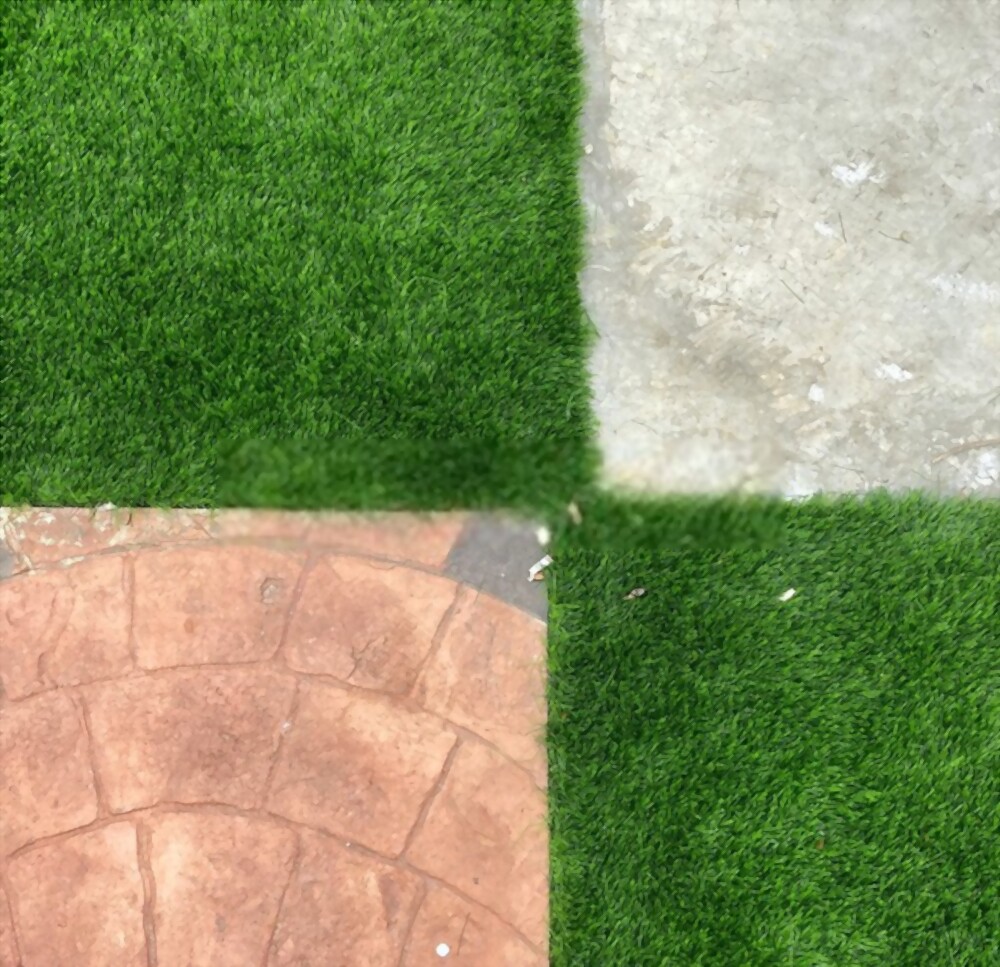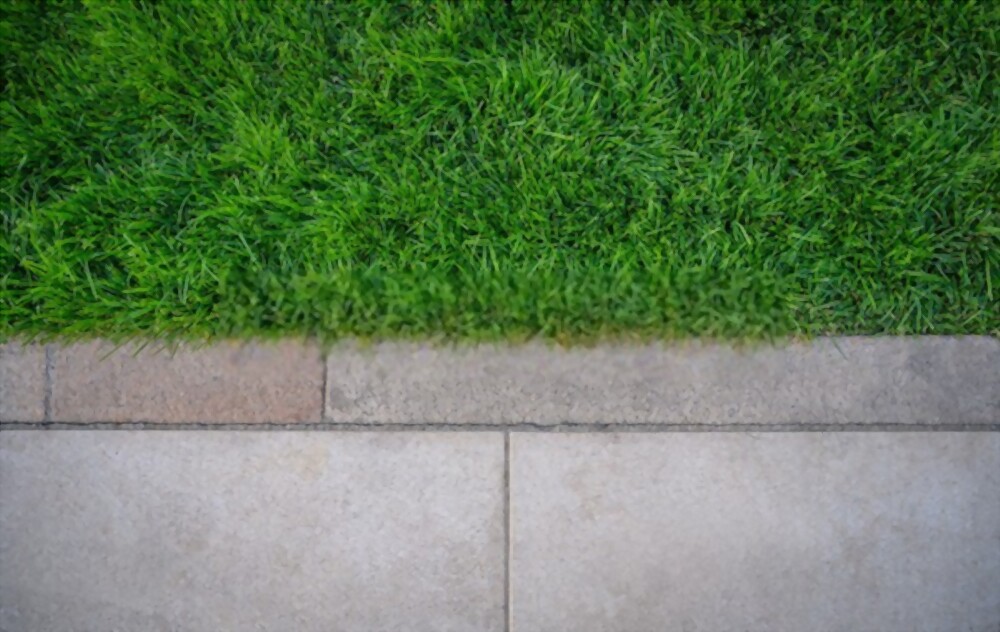By changing the chemical makeup of the soil and inhibiting the intake of nutrients for healthy growth, cement that has been fractured can impede healthy grass growth on a lawn.
Lawn grass can be killed by cement in two to three days. Limestone, which is essentially calcium carbonate, is a component of the cement (CaCO3). This chemical changes the shape of the nutrient so that it is more readily available to plants, raising the pH of the soil and finally killing the grass.
We will discuss the effects of cement on grass in this post, as well as what to do in this situation and precautions to consider when working with cement next to grassy lawns.
This inexpensive soil enhancer did wonders for the areas of my yard where the grass had died.
Table of Contents
How Does Cement Affect Grass?
Rock salt, limestone, and powdered gypsum, a type of chemical made from non-metallic minerals, make up cement.
The physio-chemical properties of soil are altered by cement’s chemical reaction with the acidic water in the soil, which may have an impact on any kind of plant or grass.
Air, water, nitrogen, iron, potassium, manganese, and microorganisms are all present in soil. The pH of soil is typically 6.4.
The amount of cement that has slipped on a certain location will determine the damages caused to the grass.
This typically occurs when building activity is carried out in a grassy lawn, agricultural field, grassland, national park, or garden for aesthetic and practical reasons, but it harms the soil, flora, and microorganisms in our environment as a whole.
Through soil chemical reactions with limestone (CaCO3), rainwater (H2O), and carbon dioxide (CO2) in the air, cement can kill grass by making the soil highly alkaline at a pH level greater than 8.0. This chemical reaction affects the lush, green grass by turning it pale.
- The mobility of nutrients in a soil is governed by its pH level. Different vegetation types can be found there.
- The movement of air, water, and nutrients in lower layers is impeded by liquid cement, which forms a solid layer or hard crust at the soil’s surface. The grassroots cannot develop and endure in the soil without their mobility.
- The grass cannot receive as much sunlight as it would otherwise, which is crucial for the creation of starch during photosynthesis. Additionally, it prevents the plants’ seeds from germinating.
- High soil alkalinity can inhibit the uptake of iron, causing grass to turn yellow.
- When the soil pH exceeds the 7.0 threshold, pink snow mold, a sort of infectious illness, strikes the grass on the lawn. Infection spreads and worsens in cool, muggy conditions. This illness makes the grass brown.
- Cement can lower soil productivity, which slows the development of all types of grass.
| Compound | Formula |
|---|---|
| Oxide of calcium (lime) | Ca0 |
| silicic acid (silica) | SiO2 |
| Oxide of aluminum (alumina) | Al2O3 |
| oxidized iron | Fe2O3 |
| Sulfate | SO3 |
I used Scotts Turf Builder, which I purchased from Amazon at a wonderful price, to restore the grass after cement poured on my yard. To view it, visit this link.
How Much Cement will it Take to Kill Grass?
The grass will typically die off over time if the ground is completely covered in a thick coating of cement.
In theory, if 1.5 mg to 3.8 mg of cement was sprinkled over 1 square meter of ground, grass may technically die from cement.
It progressively raises the pH levels of the soil and makes it extremely alkaline, which limits the ability of the grass to absorb nutrients.
How long before grass reaches its end?
After three days, grass that is exposed to cement will die. It usually takes some time for the calcium carbonate to decompose chemically by combining with the soil’s minerals and water to produce the high alkalinity, at which point the grass will begin to show signs of cement poisoning.
If alkaline soil remains in the soil, such as calcium carbonate, and cement is present at the ground as a solid layer, the grass will progressively wither.
Can you Wash Cement out from Grass?
With a shovel, you can remove a portion of the soil that is almost 4 inches deep and replace it with fertile soil and additives. then let the grass grow once more.
The removal process for this straightforward treatment uses a lot of chemicals and wastes water.
The aftereffect also encourages additional treatments, which has a snowball effect on corrective care. After all, complete cement removal from grass is not certain.
The cement will stay on the ground and run off at the soil surface if only a small amount is slid. If this happens, you can use water to wash the cement off the grass.
If a significant amount of cement slips, don’t clean it up with water; instead, replace it with healthy soil.
Large amounts of cement that have been rinsed with water can leach down and harden over time, which causes the plants nearby to die.
What can I do to Prevent Cement from Spilling onto Grass?
By employing the following techniques, we can stop cement from pouring onto grass:
- To protect the grass from cement, use plastic sheeting.
- Plan building activities away from grassy knolls and lawns.
- Following construction, plant grass (if the area is not already planted with grass)
- Grass should be cut down before construction since it can be planted again afterward.
- Observe the regrowth of grass after cement has been spilled on the ground.
Remedial Care for Grass after Cement is Spilled
In the event that cement leaks into grass, the following treatments can be applied:
- Clear the ground by digging and removing the top 5-7 inches of dirt along with the thick cement crust using a shovel, garden hoe, or tiller.
- Since dead grass won’t reseed, remove its roots, stones, rocks, and other ground clutter.
- Remove the last of the cement with a shovel or a garden hoe.
- 7 inches of the top soil layer should be replaced.
- Make sure the lawn has a level slope so that concrete can drain properly and doesn’t collect close to the grass.
- Prior to sowing new seeds, level the lawn.
- Utilize a soil test kit to determine the pH level of the soil and adhere to the product’s instructions.
- If the soil is overly alkaline, combine white synthetic vinegar and distilled water and spray it on the lawn.
- Create a level layer of dirt before sowing fresh grass seeds.
- Utilize organic fertilizers like leaves and mould to aerate the soil.
- To safeguard its output, use fertilizers and soil conditioners.
- If a tiny bit of cement leaks into grass, watch for regeneration and regrowth.
- After watering the yard for a few weeks, reseed the grass.
- On the lawn where you have recently planted grass seeds, stay off of it.
- Water the lawn thoroughly so that the soil at the roots of the grass is evenly saturated.
- Improve the lawn’s drainage.
The Takeaway
Not only is spilling cement dangerous for grasses, but it can also destroy soil, bacteria, and plant life. The problem gets worse over time as a result of the excessive construction activity.
Cement has long-lasting and challenging-to-reverse negative effects, so we must keep our grass and plants free of it.
FAQ
How do I prepare my yard for concrete?
Apply a thin layer of cement sand to the gravel and dampen it with water to strengthen the subsurface. Before pouring the concrete, let the wet sand dry for about an hour without leaving any standing water. Before pouring a driveway, sidewalk, or on a concrete slab, the ground must be properly prepared.
Can you pour concrete directly on dirt?
In conclusion, the answer is that concrete can be poured over earth.
Can you pour concrete directly over grass?
Concrete shouldn’t be immediately poured on top of grass. It is ideal to remove any vegetation and pour the concrete on top of smooth, debris-free soil for it to harden flat and smoothly. This is what? Leaving grass under your concrete slab may result in future problems that are not necessary for you.
Can you put grass on cement?
By covering the concrete surface with 1 to 2 inches of gravel or dirt and then equally scattering the seeds over the soil, grass can be grown over concrete. A firm concrete surface will support the healthy growth of fresh grass shoots with minimal fertilizer and sporadic watering.
Do I need to remove grass before concrete?
Conclusion: It’s advisable to remove all grass and loose debris before pouring concrete, even though some projects give you a little leeway by letting grass grow underneath your concrete. By doing this, you can guarantee that your appearance will be even, smooth, and crack-free for many years without having to worry with any costly or time-consuming maintenance.


